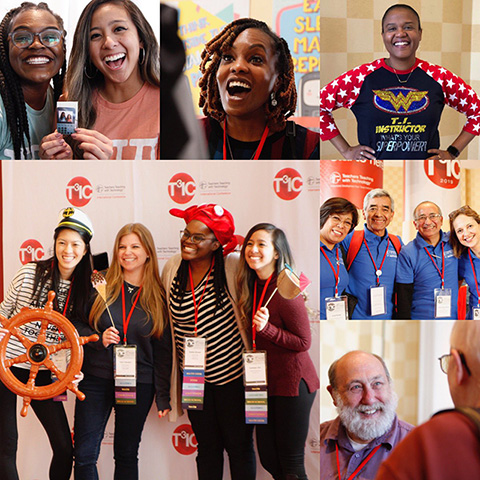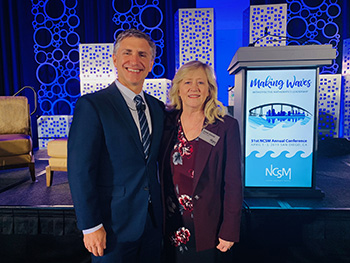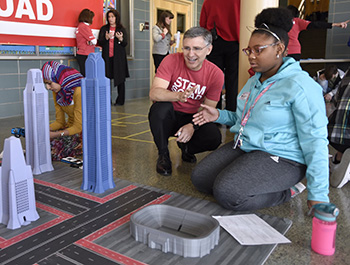Madness in March Underscores the “M” in STEM

April may be the official month for mathematics awareness, but I marked it in March through five conferences on two continents and hundreds of discussions with educators who all agree on one thing: We are in a STEM education crisis.
Many of my Texas Instruments (TI) colleagues and I experienced our own madness in March by spending most of the month on the road to talk, experience and champion STEM education, beginning at our 31st annual Teachers Teaching with Technology™ (T³™) International Conference in Baltimore. But the truth is that, for the past 30 years, we’ve worked with educators and professional associations to help give students a solid foundation in math and science to set them up for success in the classroom today, in college tomorrow and exciting careers in the future. Today, that means helping teachers find ways to make math and science relatable and inspiring to students. Without this, we will remain in a STEM crisis.

Congratulating Connie Schrock, outgoing president of NCSM, on her bold leadership in math education during the NCSM conference that focused on making waves of positive change for students.
The state of STEM education today is a good-news/bad-news story that requires immediate attention to turn it into only a good-news story. And as a parent, long-time educator and now head of TI’s education technology business, I’m optimistic that this can only be a good-news story. How? By building on what many educators are already doing — meeting kids where they are with learning tools and techniques that help them make sense of the world around them.
I’m a math guy, and I love data, so here are some facts around the opportunity to grow STEM talent.
1. Demand is high:
- STEM occupations are projected to grow by 9% from 2015 to 2024, compared to 6% growth for non-STEM occupations (“STEM Jobs: 2017 Update,” U.S. Department of Commerce)
- STEM workers command higher wages, earning 29% more than their non-STEM counterparts (“STEM Jobs: 2017 Update,” U.S. Department of Commerce)
2. Yet supply is low:
- Only 26% of all certificates or conferred college degrees in the U.S. are in STEM fields (U.S. Department of Education, 2001–2015)
- In Texas alone, there are an estimated 715,000 STEM jobs waiting to be filled (Girl Scouts of Northeast Texas STEM study, 2017)
3. Even worse? Student interest in STEM careers remains stagnant, and even if they were interested in STEM, they aren’t equipped for success:
- Less than half of high school graduates express an interest in a STEM field (“The Condition of STEM 2017,” ACT®)
- Only one-half of 1% of students plan to major in math or science education (“The Condition of College & Career Readiness 2017,” ACT®)
- 41% of students are meeting the ACT® math benchmark score of 22; 37% are meeting the ACT® science benchmark score of 23; and 21% are meeting the ACT® STEM benchmark score of 26 (“The Condition of College & Career Readiness 2017,” ACT®)
But, there is good news! The deficiencies we have in STEM have caught the attention of many stakeholders — from federal, state and local policymakers, to parents, educators and school districts, to foundations and industries, and to national organizations such as Girl Scouts — who are contributing and collaborating productively to the STEM conversation to effect change. In fact, in the U.S. federal government’s recently published federal STEM strategic plan, “Charting a Course for Success: America’s Strategy for STEM Education,” math is specifically referred to as the foundation for all STEM learning.

During the Sharing Inspiration conference in Brussels, learning more about Insa Thiele-Eich’s journey to becoming Germany’s first female astronaut to reach the International Space Station.
The reliance upon a robust and equitable STEM education experience for our kids is paramount, and the rallying cry for this is getting louder, but not just in the U.S. At T3 Europe’s Sharing Inspiration 2019 conference in Brussels, educators from across Europe explored ways to translate STEM teaching frameworks and guidelines into actionable plans that will pique student interest and increase confidence in STEM subjects.

To honor World Math Day, TI’s STEM Squad spread out across 11 Baltimore County schools to give students the opportunity to experience math in a fun, interactive and hands-on way.
At the Association of State Supervisors of Mathematics conference in San Diego, leaders of mathematics education were having the same discussions. During the National Council of Supervisors of Mathematics conference, there were passionate discussions about making positive waves of change in the classroom. And finally, at the National Council of Teachers of Mathematics annual conference, teachers taught teachers through concrete examples of how they’re getting students hooked on STEM.
Why do all these discussions around a quality STEM education for our kids matter? Job opportunities aside, it’s because we live in a world that doesn’t just require STEM skills, it demands them. For our students, that means STEM skills are survival skills. For our teachers, our world’s real super heroes, ongoing professional development that includes the use of technology in the classroom is more important than ever to ensure their students are equipped with those skills. And it’s on all of us — industry, educators, parents, policymakers — to help all students build their confidence in STEM subjects so that they will have the courage to pursue advanced courses and the option to pursue exciting and rewarding STEM careers.
STEM education is a heroic endeavor that requires a lot of effort across many people. It’s important that we give students positive STEM learning experiences so they have their own superpowers to discover solutions to any problem they face in school and in life. Individually, we can all move the needle to improve STEM learning gaps. But, I am convinced that we could really change this equation and, most importantly, change the results if we work together.
ACT is a registered trademark of ACT, Inc., which does not endorse TI products. Policies subject to change. Visit www.act.org.
About The Author: Peter Balyta, Ph.D., leads academic engagement and corporate citizenship for Texas Instruments and is the president of TI Education Technology. He serves on a variety of boards that support his desire to engage students in STEM subjects, including the board of directors of Girl Scouts of Northeast Texas. Follow him on Twitter @pbalyta.
Tagcloud
Archive
- 2025
- 2024
- 2023
- 2022
-
2021
- January (2)
- February (3)
- March (5)
-
April (7)
- Top Tips for Tackling the SAT® with the TI-84 Plus CE
- Monday Night Calculus With Steve Kokoska and Tom Dick
- Which TI Calculator for the SAT® and Why?
- Top Tips From a Math Teacher for Taking the Online AP® Exam
- Celebrate National Robotics Week With Supervised Teardowns
- How To Use the TI-84 Plus Family of Graphing Calculators To Succeed on the ACT®
- AP® Statistics: 6 Math Functions You Must Know for the TI-84 Plus
- May (1)
- June (3)
- July (2)
- August (5)
- September (2)
-
October (4)
- Transformation Graphing — the Families of Functions Modular Video Series to the Rescue!
- Top 3 Halloween-Themed Classroom Activities
- In Honor of National Chemistry Week, 5 “Organic” Ways to Incorporate TI Technology Into Chemistry Class
- 5 Spook-tacular Ways to Bring the Halloween “Spirits” Into Your Classroom
- November (4)
- December (1)
-
2020
- January (2)
- February (1)
- March (3)
- April (1)
- May (2)
- July (1)
- August (2)
- September (3)
-
October (7)
- Tips for Teachers in the time of COVID-19
- Top 10 Features of TI-84 Plus for Taking the ACT®
- TI Codes Contest Winners Revealed
- Best of Chemistry Activities for the Fall Semester
- Best of Biology Activities for the Fall Semester
- Best of Physics Activities for the Fall Semester
- Best of Middle Grades Science Activities
- November (1)
- December (2)
- 2019
-
2018
- January (1)
- February (5)
- March (4)
- April (5)
- May (4)
- June (4)
- July (4)
- August (4)
- September (5)
-
October (9)
- Art in Chemistry
- Which Texas Instruments (TI) Calculator for the ACT® and Why?
- Meet TI Teacher of the Month: Jessica Kohout
- Innovation in Biology
- Learning With Your Students
- A first-of-its-kind STEM strategy charts path to help educators
- #NCTMregionals Hartford 2018 Recap
- The Math Behind “Going Viral”
- Real-World Applications of Chemistry
-
November (8)
- Testing Tips: Using Calculators on Class Assessments
- Girls in STEM: A Personal Perspective
- 5 Teachers You Should Be Following on Instagram Right Now
- Meet TI Teacher of the Month: Katie England
- End-of-Marking Period Feedback Is a Two-Way Street
- #NCTMregionals Kansas City 2018 Recap
- Slope: It Shouldn’t Just Be a Formula
- Hit a high note exploring the math behind music
- December (5)
- 2017
- 2016
- 2015
